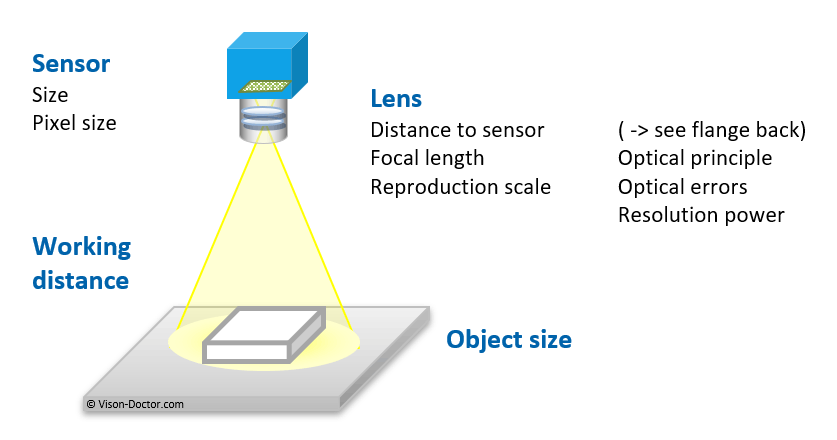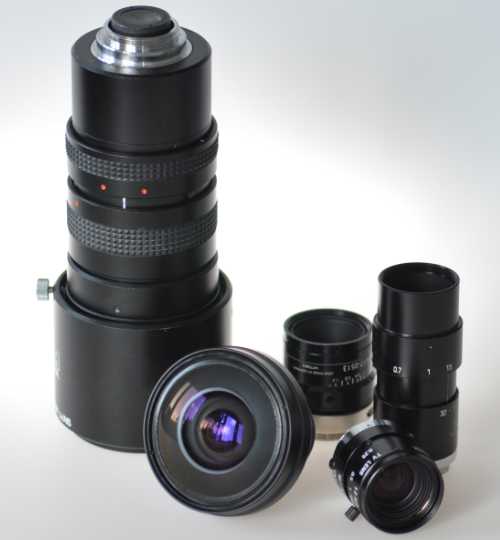
Optics
SELECTION OF THE APPROPRIATE OPTICS
The selection of an appropriate lens is essential: not the test object as such is captured and processed by the software, but a video image - an image which the optics on the sensor captures and which is "interpreted" by the camera sensor. All components like lighting, the test object, a suitable filter, the camera sensor and, in particular, the optics is significantly involved in the "picture" visible and evaluable on the monitor.
In practice, each lens has varyingly strong optical faults, depending on the quality, which are adopted in the image information. Several per cent of distortion, for instance, (geometric fault as barrel or pincushion distortion) are common for standard optics. Therefore the measuring results will vary by this fault tolerance, provided that there are no subsequent calibrations on the software side.
Typical types of lenses
"Regular" lenses
Entocentric standard optics (For normal use)
Lenses for measurements
Telecentric measuring lenses (For precise measuring tasks)
Lenses for specific wavelengths
Colour-corrected lenses (for coloured objects and colour applications, but also for use of non-monochromatic white light) as well as IR or UV lenses
For variable magnification
Zoom lenses (mainly used in laboratories, motorised zoom lenses in machine vision applications are rarely usefully applicable)
Lenses for smallest fields of view
Macro lenses and microscope optics (for smallest image details)

Selection of the appropriate optics
There are a few things to consider when choosing the right lens:
Firstly, the lens must fit the existing camera. There are different types of mounts, such as C-mount, CS-mount, S-mount, F-mount, M42 to M72. With the exception of F-mount (Nikon bayonet), all lenses can generally be screwed in with a fine thread.
Put simply, all you need to do is calculate the correct focal length of the lens for a given working distance and make sure that the lens can expose the sensor to fill the format (sufficiently large image circle diameter).
However, optical details such as resolution, MTF, coatings, etc. and especially the type of optical imaging should also be taken into account in order to obtain the best possible image for evaluation.

Important lens selection criteria
1. Size of the inspected object or the object area to be detected
The dimensions of the object to be inspected or the area to be imaged play a key role in the choice of optics. The larger the object size or area, the wider the optical perspective of the optics must be to ensure complete and accurate depiction. Alternatively, the working distance can be adjusted.
2. Working distance
The working distance is the distance between the test object and the optics (and can be easily calculated). Note: A distinction must be made between the 'free working distance' and the calculated values up to the first main optical plane.
3. Sensor size
The Sensor size defined by the camera determines the image size and influences the choice of lens. In simple terms, the correct focal length for the lens must now be calculated for a given working distance and the lens must be able to expose the sensor to fill the format (sufficiently large image circle diameter).
4. Distance between optics and sensor
The distance between the lens and the sensor is defined by the camera manufacturer. Different standards are used, such as C-mount, CS-mount or F-mount, which have different flange back distances.
For M42 etc. specific extension adapters/tubes must be calculated.
5. Camera sensor type
The type of camera sensor influences the required resolution of the optics. Important factors are pixel size and very specific details such as micro-lenses on chip. These details are critical to achieving high image quality and accurate defect detection.
6. Sensor mount
First of all, the lens must be mountable on the existing camera. There are various lens mounts, such as C-mount, CS-mount, S-mount, F-mount, M42 to M72. With the exception of F-mount (Nikon bayonet), all lenses in this list can generally be screwed in with a fine thread.
7. Desired optical principle
The desired optical path can be either entocentric or telecentric and requires a different design. Macro lenses/microscope systems also require special design.
8. Aperture / min. f-number of the lens
The lens speed and aperture determine the amount of light that hits the sensor and the depth of field of the image. A wider aperture lets in more light, which is especially important in low light.
9. Wavelength of light
The wavelength of the light, whether (monochromatic-coloured/ white mixed light, daylight/ IR/ UV, has a significant effect on image processing. Different wavelengths are better suited to different materials and defect characteristics. The lens must therefore be suitable for the wavelengths used.
Need to buy the perfect lens?
Vision-Doctor.com is a private, independent, non-commercial homepage project and not a technology provider or system integrator. Suitable technologies and further professional support can be obtained from the companies & partners listed below.
If necessary, I will be happy to provide a quick recommendation, contacts and brief information.















